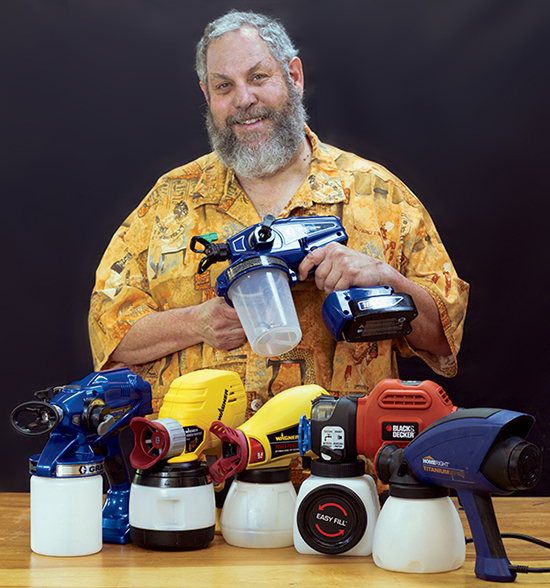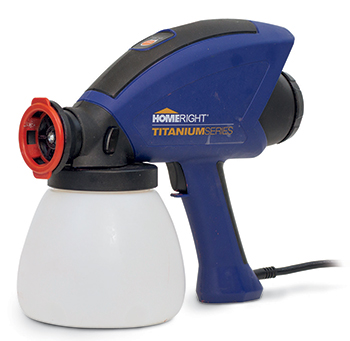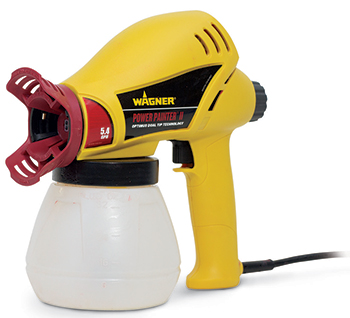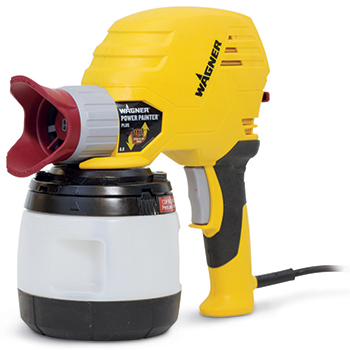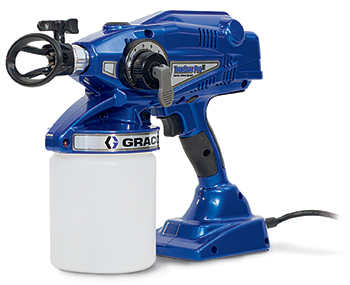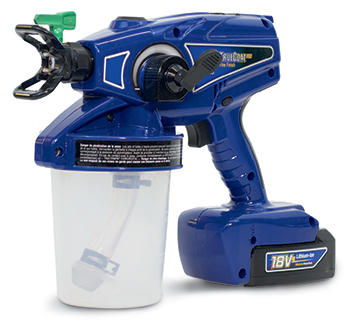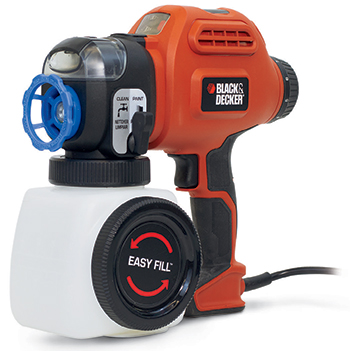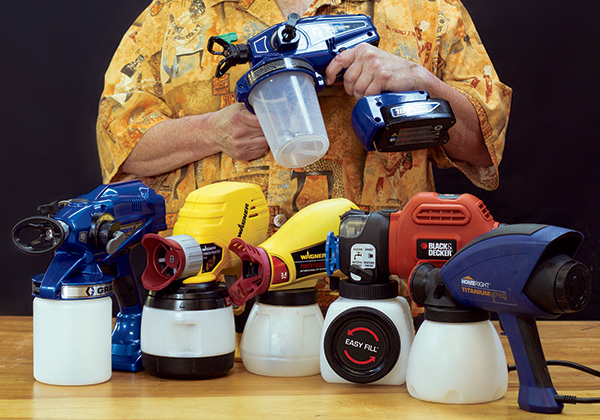
No compressor, no turbine, no hose — no problem! Airless sprayers provide a new option for quick, efficient spraying.
The compact airless electric spray gun is the new kid on the block of spray guns. This self-contained, handheld tool sprays paint, stain, varnish or lacquer quickly, without having to thin it with solvent. Since they’re relatively new to the market, we thought we’d take a look at a few and see whether they’re something we should invite into our shops and homes.
How Does it Work?
Most spray guns I’ve used were connected to sources of air: compressors for standard or conversion guns; turbines for HVLP guns. By injecting a stream of finish into the fast- moving air, the finish atomizes into airborne droplets.
Airless, as the name implies, uses no air at all. Instead of mixing liquid with air, it forces a stream of finish at very high pressure through a tiny, shaped aperture that causes it to spread out and atomize, breaking the liquid up into droplets as it emerges from the gun.
Think of it as a higher pressure version of your showerhead, or the nozzle on your garden hose. Both are examples of airless spraying. In this case, a liquid pump generates much higher pressures, enabling the gun to atomize much thicker materials than water.
You’ve probably seen house painters using large airless systems that consist of a pump, usually on a stand, with a hose that goes from a bucket of paint, through the pump, and on to the gun. The guns here are smaller versions of the same technology in
self-contained, handheld units that plug into standard electrical outlets. One gun in our test is battery-powered, so there’s not even a cord to deal with.
Advantages?
First and foremost, there’s versatility. Airless guns will spray just about any finish at full viscosity, usually without the need for any thinner at all. The same gun will often handle right-out-of-the-can unreduced house paint, deck coating, thin lacquer, oil-based polyurethane, or your favorite furniture stain.
Not needing to reduce the finish not only saves you buying expensive solvents (except those you need for cleaning), but it also means that each coat of finish contains more solids, and thus builds much faster. When you reduce a coating by 50% in order to spray it, all that solvent has to evaporate off, leaving you with, at best, only 50% of the wet thickness you applied.
Transfer efficiency is the measure of how much of the finish that comes out of the gun actually lands on the wood. While other spray methods vary, laboratory tests have repeatedly shown that airless is by far the most efficient. Without air blowing the finish hither and yon, a very high percentage of coating ends up on the wood.
Speed is another strength. In terms of volume, airless guns move finish much more quickly than any other type of spray gun. Even the smallest in our test sample can spray a gallon of finish in about 10 minutes.
Disadvantages?
On the other hand, speed can also be a disadvantage. Anything that moves that much finish that quickly is harder to control, especially if you only want to apply a thin coat. However, this generation of handheld airless guns sports controls for both the volume and power, letting you dial back the flow for thinner materials that you might want to spray more sparsely. Still, expect to set aside some time to practice spraying cardboard and scrap wood.
Perhaps the one big draw- back is the weight. Because you are carrying around a small pump in addition to a cup of paint or finish, these guns get heavy very quickly. One perk: they all have available or included attachments that let you remove the cup portion and attach a hose directly into a can of paint or finish. At least that way, you aren’t carrying around a quart of finish in addition to the gun.
The Field
We looked at a handful of the most available brands to see how they stacked up and what features each offers. To test them, we sprayed a variety of unreduced materials, including house paint, water-based polyurethane, oil-based polyurethane and lacquer through each gun. They vary, but all are worth taking a serious look at, should you have the opportunity to get your hands on them.
Do read the instructions with each gun. Some require a small amount of assembly, and all need to be lubricated each time you use them. All disassemble for cleaning, and all of them have a rotating sleeve that allows you to change the fan pattern, when using the fan tip, from horizontal to vertical.
Before we jump into the descriptions of each gun, I’ll answer a question you may be about to ask: Would I, an experienced finishing expert, have one of these in my shop or garage? Yep, I sure would. In fact, I do. It’s not the only gun or system I own, but it sure is handy at times.
HomeRight Heavy Duty Paint Sprayer Titanium Series
List Price: $120
Heavy Duty Paint Sprayer Titanium Series
Weight (empty): 3 lbs., 15 oz.
Cord Length: 18 in. (use with extension cord)
Comes with: Two spray tips, 5-ft. suction tube and clamp (for spraying directly out of a can or bucket of paint), two replacement atomizers, a cleaning brush and lubricant oil storage kit, and a 2-year warranty
HomeRight is a fairly small company in Minneapolis, and this gun is a new entry onto the market. For that reason it is currently available only online through Amazon, The Home Depot, and Lowe’s®. The latter two offer in-store pickup at many locations.
One of the lighter, and oddly enough, louder, guns, this sprayer is well-balanced and comfortable. There’s a high/ low motor speed button at the top of the gun, and a dial at the back for heavy vs. light material flow.
Inside the screw-off cup, a flexible pendulum shaft flow tube continues drawing paint at any angle you hold the gun. A pair of buttons on either side near the front of the gun releases the entire spray and cup mechanism from the body for cleaning. Ours hung up a bit until we removed it once, then lubricated it with Vaseline®, after which it popped out as it should when the buttons were pressed.
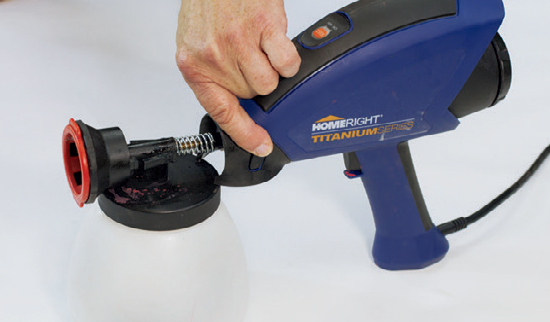
Wagner Power Painter II
Power Painter II
List Price: $80
Weight (empty): 3.85 lbs.
Cord Length: 18 in. (use with extension cord) Comes with: Spare atomization valve, cleaning brush, lubricating oil
This comfortable, easy-to-use gun is the smaller sibling of the Power Painter Plus (below). It’s got a single dial at the back for fluid flow control, and inside the screw-off cup, a fllexible pendulum shaft flow tube continues drawing paint at any angle you hold the gun. Unscrewing the tip and retainer ring releases the en- tire spray and cup mechanism from the body for cleaning.
Perhaps most unique is the two-aperture spray tip, designed for a better, more even fan pattern. This is a lovely entry-level gun that handled everything we put it through without a hitch.
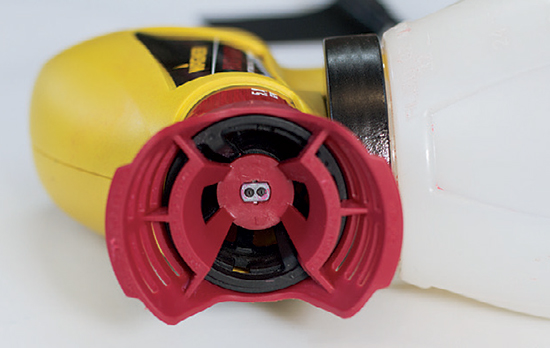
Wagner Power Painter Plus
Power Painter Plus
List Price: $100
Weight (empty): 4.5 lbs.
Cord Length: 14 in. (use with extension cord)
Comes with: Paint can pouring lid, cleaning brushes, lubricating oil, spare atomization valve, and a garden hose attachment for easy cleaning of the gun’s fluid passageways (for water-based paint, of course)
Along with the very nice two-aperture spray tip (see Power Painter II above), this more powerful gun also has a push-and-release cup, replete with hand-grab recesses. Push the button and turn the cup barely an eighth of a rotation, and it pops off. As with many of the others, inside the cup, a flexible pendulum shaft flow tube continues drawing paint at any angle you hold the gun.
On the back of the gun is a clearly marked, multiposition “stain/paint” switch for controlling flow of heavy and lighter materials, since this gun sprays the full range of materials.
Unscrewing the tip and retainer ring releases the entire spray and cup mechanism from the body for cleaning.
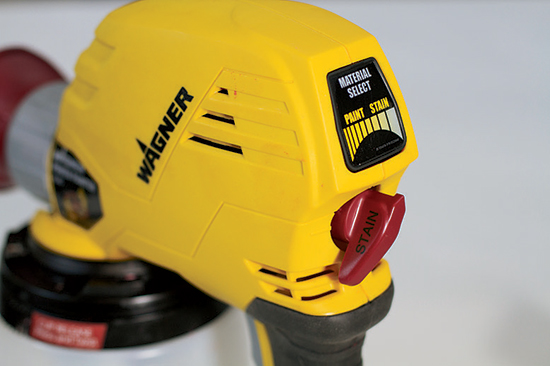
Graco TrueCoat® Pro II Electric
TrueCoat Pro II Electric
List Price: $358
Weight (empty): 6.86 lbs.
Cord length: 15 ft.
Comes with: Cup cover and liners, lubricant, instructional DVD, and hard shell storage case. Ours also came with a “can connect” conversion kit to spray directly from a paint can or bucket.
This is a big, heavy, powerful, professional quality gun, loaded with features and capable of moving a lot of material of any viscosity. All-metal interior construction, meant for longer life, accounts for the weight.
The spray tip, with an obvious arrow showing flow direction, flips over to allow you to clear it instantly, then back again to spray. One dial on the side of the gun constitutes all the controls you need to spray a wide range of coatings. Inside
the screw-off cup, a flexible pendulum shaft flow tube continues drawing paint at any angle you hold the gun, and the cup itself has straight sides, making cleaning easier. There’s even a trigger lock.
They suggest you use the Fine Finish gun (next) for hot solvent finishes, but we sprayed lacquer through this and it did just find.
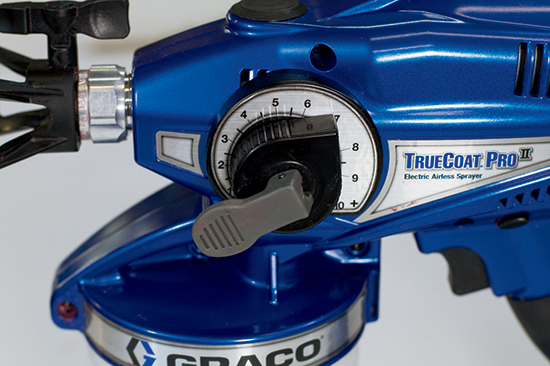
Graco True Coat® Pro II Fine Finish (Cordless)
Graco TrueCoat Pro II Fine Finish (Cordless)
List price $696
Weight (empty): 5.3 lbs. (with battery)
Cord length: N/A (battery-powered)
Comes with: Two 18V lithium-ion batteries, battery charger, two reversible spray tips, a cup cover and liners, lubricant, and a hard-shell storage case
This cordless sibling of the Pro II Electric is equally well-built, with a two-position motor speed switch, a trigger lock, and the same side-mounted fluid control and flip-over, self-clearing spray tips. Inside the cup, which has straight, angled sides for easy cleaning, is a fluid spout that can be positioned for drawing from the front, back, or side of the cup.
A push-button-release battery comes with a charger that not only powers up in only 25 minutes, but pops the battery out of the charger when it is done. Graco suggests you use this gun for hot solvent and thin finishes, but we found it handled everything, including unthinned paint, beautifully. Yes, it’s a bit expensive, but it’s a very sweet gun.
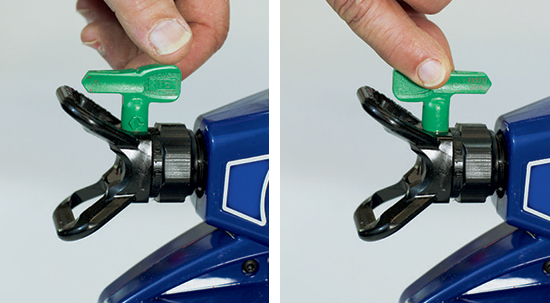
Black & Decker 2-Speed Quick CleanTM Sprayer
List price: $99
Weight (empty): 5 lbs.
Cord length: 20 in. (use with extension cord)
Comes with: Two nozzles, three atomizers, cleaning brush, lubricating oil, pouring paint bucket, direct to can or bucket conversion kit
This gun has some of the coolest features of all, starting with its unique side-fill lid. Normally, you have to unscrew a cup to refill it, and when you pull the dangling fluid stem out, it drips paint all over the place. Here, you simply lay it on its side, unscrew the black Easy FillTM cap, and pour in more paint. It’s clean and easy, and they even include a fill bucket with a pouring spout.
Then there’s the switch on the side near the nozzle. Turn it from paint to clean, open the tiny trap door on the top of the gun, and you can pour in water or cleaning thinner, pull the trigger, and clean the tip that way. Like the side fill feature, it’s simple but brilliant.
The cup itself detaches via a threaded retaining ring. A push button on top of the gun releases the entire front end, including the spray mechanism and cup. A large flow control knob at the rear of the gun is clearly marked, but the two-speed push-button motor control is not; its high and low icons are hard to see.
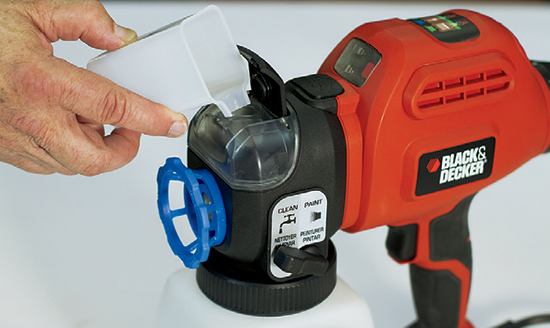
Reconsidering airless spray guns
These guns represent a new generation of airless spraying, with more finesse, more control, and the ability to spray both thin and thick materials. If your only experience with airless sprayers has been cumbersome behemoths designed to belch out huge volumes of paint, you owe it to yourself to take a look at these. I suspect you’ll be very pleasantly surprised.
